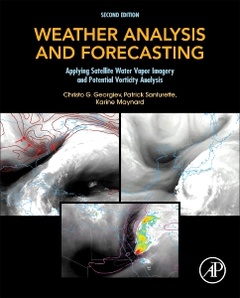Weather Analysis and Forecasting (2nd Ed.) Applying Satellite Water Vapor Imagery and Potential Vorticity Analysis
Auteurs : Georgiev Christo, Santurette Patrick, Maynard Karine

Patrick Santurette is the current Head of Météo-France Marine and Oceanographic department after being head of the Météo-France Forecast Laboratory where he has worked for 19 years, in collaboration with operational forecasters to improve their methods and tools. Previously he worked during 10 years as senior forecaster in the National Forecasting Centre of Météo-France. Dr. Santurette is in daily contact with operational forecasters, and he regularly organizes workshops dedicated to French operational forecasters. Dr. Santurette actively participates in forecast training in the framework of the Météo-France school, including those held in English for foreign weather services.
Karine Maynard works in the Forecast Laboratory inside the forecasting department of Météo-France for eleven years. She received a PhD degree in atmospheric dynamics in 1997 from the Pierre et Marie Curie University, Paris. She was then a Postdoctoral Research Fellows and works on impact on land-use changes on the African Climate and on impact of land-surface processes on the inter-annual variability of tropical climate. In September 2004, she joined the Forecast Laboratory of Météo-France where she works in collaboration with operational forecasters to improve their methods and tools.
- Presents interpretation of the water vapor channels 6.2 and 7.3µm as well as advances based on satellite data to improve understanding of atmospheric thermodynamics
- Improves by new schemes the understanding of upper-level dynamics, midlatitudes cyclogenesis and fronts over various geographical areas
- Provides analysis of deep convective phenomena to better understand the development of strong thunderstorms and to improve forecasting of severe convective events
- Includes efficient operational forecasting methods for interpretation of data from NWP models
- Offers information on satellite water vapor images and potential vorticity fields to analyse and forecast convective phenomena and thunderstorms
Date de parution : 07-2016
Ouvrage de 360 p.
19x23.3 cm
Thème de Weather Analysis and Forecasting :
Mots-clés :
Assessing numerical weather prediction model output; Atmospheric fronts; Baroclinic zone; Blocking circulation; Convection in subtropical and tropical areas; Convective environment; Convective ingredients; Cyclogenesis; Deep moist convection; Dynamical tropopause; Extratropical transition; Geostationary satellites; Imagery interpretation; Jet streak; Jet streams; Meteorology; Midlatitude upper-level dynamics; Moisture supply; Potential vorticity anomalies; Potential vorticity modification; Potential vorticity; Preconvective environment; Radiation effects; Sensitivity studies; Synoptic development; Synthetic satellite images; Tropical cyclone intensification; Tropopause dynamic anomaly; Upper-troposphere dynamics; Water vapor channels; Water vapor imagery; Satellite meteorology; Weather analysis; Weather forecasting; Atmospheric thermodynamics; Satellite water vapor imagery; Potential vorticity concept



